ECO mode Acura TL 2000 3.2 Owner's Manual
[x] Cancel search | Manufacturer: ACURA, Model Year: 2000, Model line: TL, Model: Acura TL 2000Pages: 311, PDF Size: 3.05 MB
Page 9 of 311
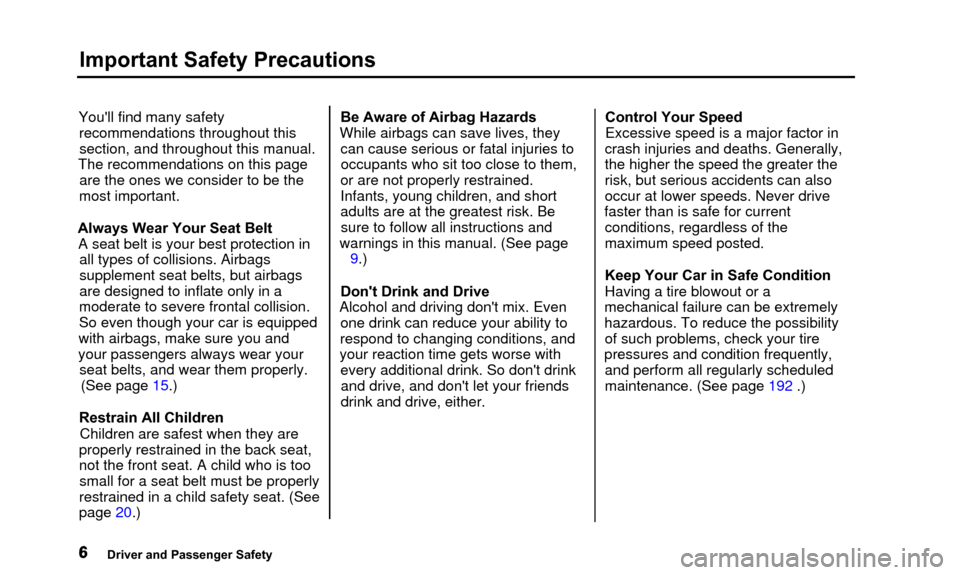
Important Safety Precautions
You'll find many safetyrecommendations throughout thissection, and throughout this manual.
The recommendations on this page are the ones we consider to be the
most important.
Always Wear Your Seat Belt A seat belt is your best protection in all types of collisions. Airbags
supplement seat belts, but airbags
are designed to inflate only in a
moderate to severe frontal collision.
So even though your car is equipped
with airbags, make sure you and
your passengers always wear your seat belts, and wear them properly. (See page 15.)
Restrain All Children Children are safest when they are
properly restrained in the back seat,
not the front seat. A child who is too small for a seat belt must be properly
restrained in a child safety seat. (See page 20.) Be Aware of Airbag Hazards
While airbags can save lives, they can cause serious or fatal injuries tooccupants who sit too close to them,
or are not properly restrained.
Infants, young children, and short
adults are at the greatest risk. Be sure to follow all instructions and
warnings in this manual. (See page 9.)
Don't Drink and Drive
Alcohol and driving don't mix. Even one drink can reduce your ability to
respond to changing conditions, and
your reaction time gets worse with every additional drink. So don't drinkand drive, and don't let your friends
drink and drive, either. Control Your Speed
Excessive speed is a major factor in
crash injuries and deaths. Generally,
the higher the speed the greater the
risk, but serious accidents can also
occur at lower speeds. Never drive
faster than is safe for current conditions, regardless of the
maximum speed posted.
Keep Your Car in Safe Condition
Having a tire blowout or a
mechanical failure can be extremely
hazardous. To reduce the possibility of such problems, check your tire
pressures and condition frequently, and perform all regularly scheduledmaintenance. (See page 192 .)
Driver and Passenger Safety
Page 24 of 311
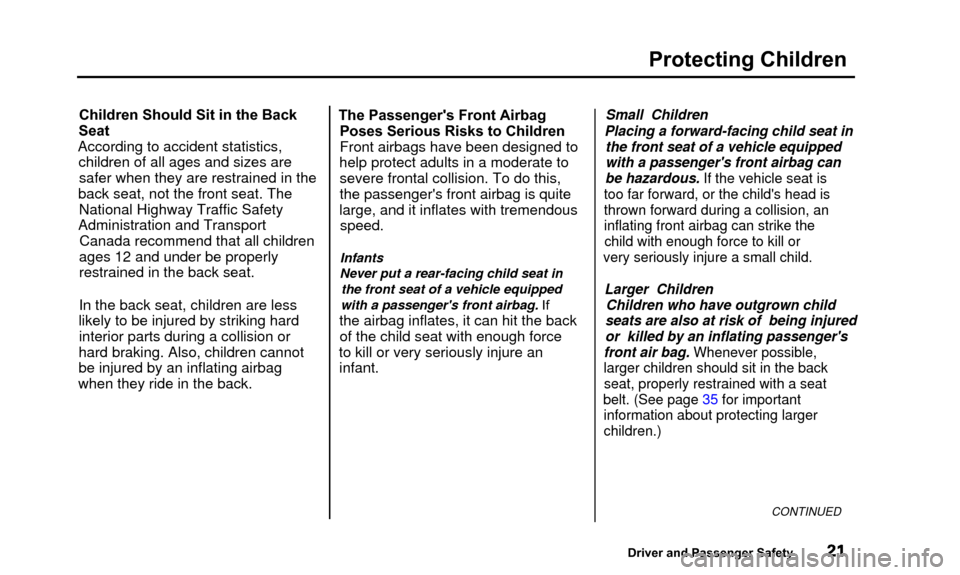
Protecting Children
Children Should Sit in the Back
Seat
According to accident statistics, children of all ages and sizes aresafer when they are restrained in the
back seat, not the front seat. The National Highway Traffic Safety
Administration and Transport Canada recommend that all children
ages 12 and under be properly
restrained in the back seat.
In the back seat, children are less
likely to be injured by striking hard interior parts during a collision or
hard braking. Also, children cannot
be injured by an inflating airbag
when they ride in the back. The Passenger's Front Airbag
Poses Serious Risks to Children
Front airbags have been designed to
help protect adults in a moderate to severe frontal collision. To do this,
the passenger's front airbag is quite
large, and it inflates with tremendous speed.
Infants
Never put a rear-facing child seat in
the front seat of a vehicle equipped
with a passenger's front airbag. If
the airbag inflates, it can hit the back of the child seat with enough force
to kill or very seriously injure an infant.
Small Children
Placing a forward-facing child seat in the front seat of a vehicle equipped
with a passenger's front airbag can
be hazardous. If the vehicle seat is
too far forward, or the child's head is
thrown forward during a collision, an
inflating front airbag can strike the child with enough force to kill or
very seriously injure a small child.
Larger Children Children who have outgrown child
seats are also at risk of being injured
or killed by an inflating passenger's
front air bag. Whenever possible,
larger children should sit in the back seat, properly restrained with a seat
belt. (See page 35 for important information about protecting larger
children.)
CONTINUED
Driver and Passenger Safety
Page 28 of 311
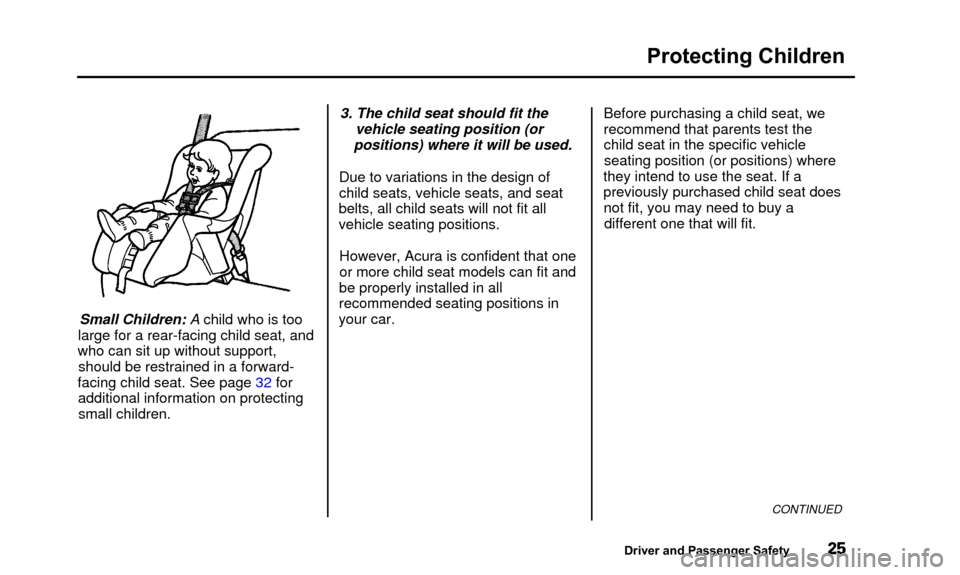
Protecting Children
Small Children: A child who is too
large for a rear-facing child seat, and
who can sit up without support, should be restrained in a forward-
facing child seat. See page 32 for additional information on protectingsmall children. 3. The child seat should fit the
vehicle seating position (or
positions) where it will be used.
Due to variations in the design of
child seats, vehicle seats, and seat
belts, all child seats will not fit all vehicle seating positions.
However, Acura is confident that one
or more child seat models can fit and
be properly installed in all
recommended seating positions in
your car. Before purchasing a child seat, we
recommend that parents test the
child seat in the specific vehicle
seating position (or positions) where
they intend to use the seat. If a
previously purchased child seat does not fit, you may need to buy a different one that will fit.
CONTINUED
Driver and Passenger Safety
Page 31 of 311
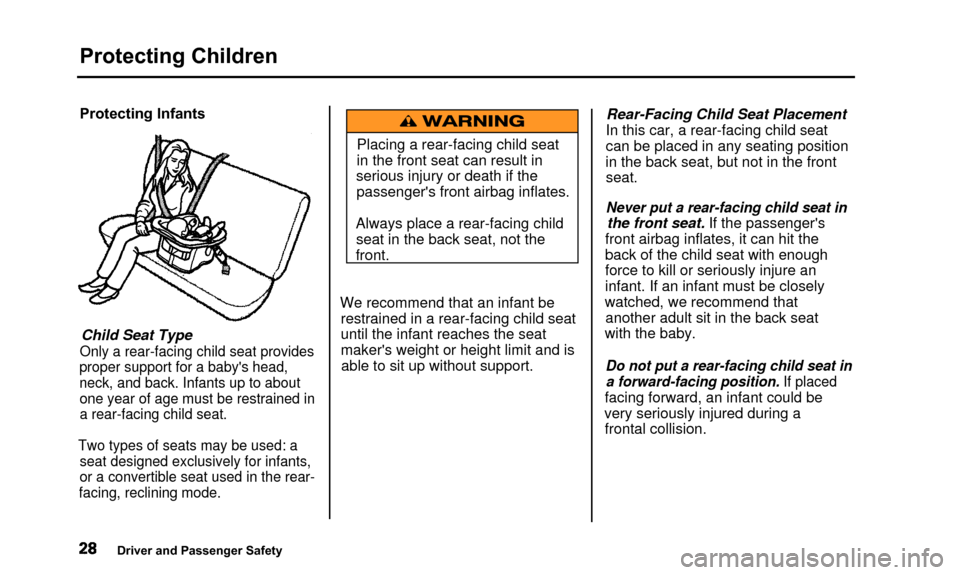
Protecting Children
Protecting InfantsChild Seat Type
Only a rear-facing child seat provides
proper support for a baby's head,
neck, and back. Infants up to about one year of age must be restrained in
a rear-facing child seat.
Two types of seats may be used: a seat designed exclusively for infants,
or a convertible seat used in the rear-
facing, reclining mode.
Placing a rear-facing child seat
in the front seat can result in
serious injury or death if the passenger's front airbag inflates.
Always place a rear-facing child seat in the back seat, not the
front.
We recommend that an infant be restrained in a rear-facing child seat
until the infant reaches the seat
maker's weight or height limit and isable to sit up without support. Rear-Facing Child Seat Placement
In this car, a rear-facing child seat
can be placed in any seating position
in the back seat, but not in the front seat.
Never put a rear-facing child seat in
the front seat. If the passenger's
front airbag inflates, it can hit the
back of the child seat with enough
force to kill or seriously injure an
infant. If an infant must be closely
watched, we recommend that another adult sit in the back seat
with the baby.
Do not put a rear-facing child seat in a forward-facing position. If placed
facing forward, an infant could be
very seriously injured during a frontal collision.
Driver and Passenger Safety
Page 46 of 311
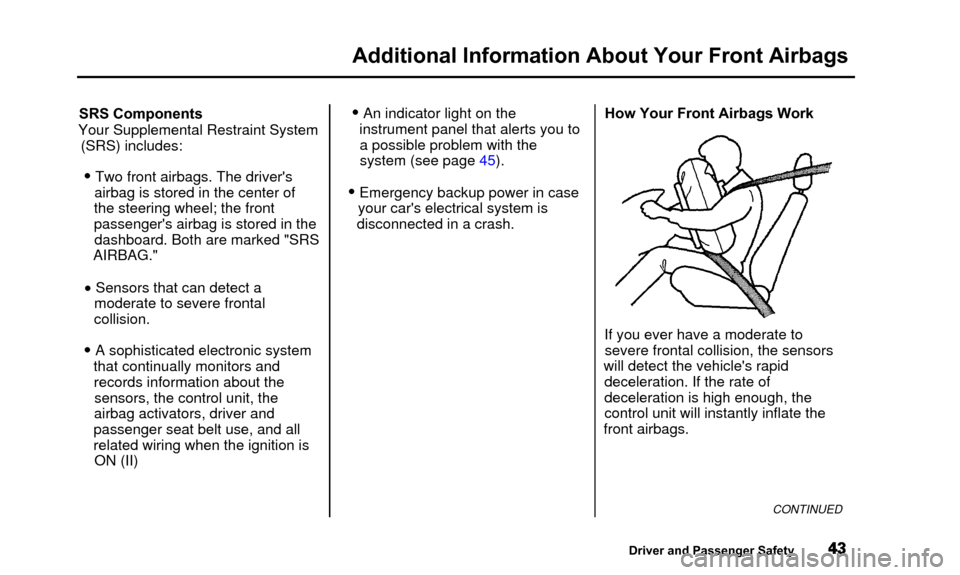
Additional Information About Your Front Airbags
SRS Components
Your Supplemental Restraint System (SRS) includes:
• Two front airbags. The driver's airbag is stored in the center of
the steering wheel; the front
passenger's airbag is stored in the dashboard. Both are marked "SRS
AIRBAG."
• Sensors that can detect a moderate to severe frontal
collision.
• A sophisticated electronic system that continually monitors andrecords information about thesensors, the control unit, the
airbag activators, driver and
passenger seat belt use, and all related wiring when the ignition is ON (II)
• An indicator light on theinstrument panel that alerts you to a possible problem with the
system (see page 45).
• Emergency backup power in case your car's electrical system is
disconnected in a crash. How Your Front Airbags Work
If you ever have a moderate to severe frontal collision, the sensors
will detect the vehicle's rapid deceleration. If the rate of
deceleration is high enough, the
control unit will instantly inflate the
front airbags.
CONTINUED
Driver and Passenger Safety
Page 53 of 311
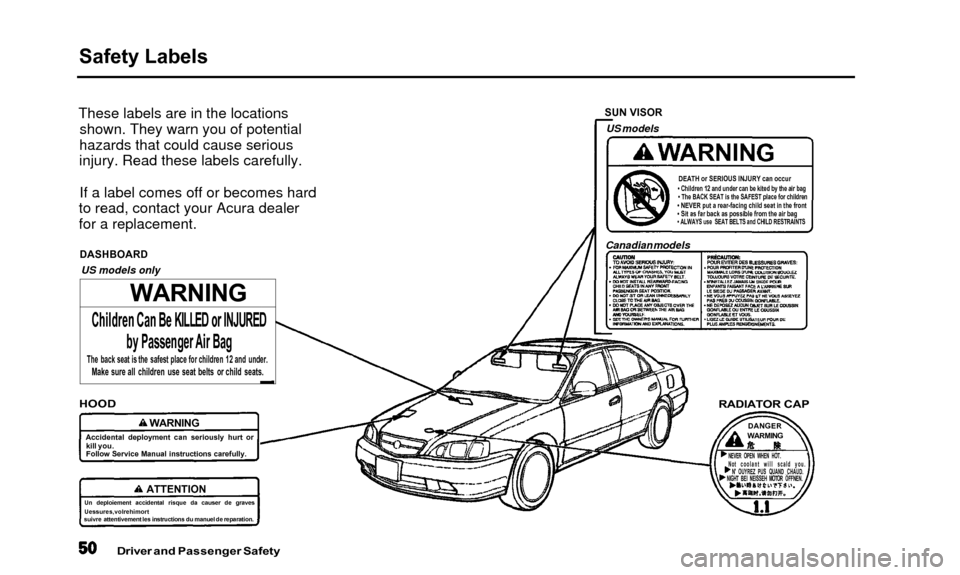
Safety Labels
These labels are in the locationsshown. They warn you of potential
hazards that could cause serious
injury. Read these labels carefully.
If a label comes off or becomes hard
to read, contact your Acura dealer
for a replacement.
DASHBOARD
US models only SUN VISOR
US models
DEATH or SERIOUS INJURY can occur• Children 12 and under can be kited by the air bag• The BACK SEAT is the SAFEST place for children
• NEVER put a rear-facing child seat in the front
• Sit as far back as possible from the air bag
• ALWAYS use SEAT BELTS and CHILD RESTRAINTS
Canadian models
HOOD
Accidental deployment can seriously hurt or
kill you.
Follow Service Manual instructions carefully.
Un deploiemen t accidental risque da causer de graves
Uessures,volrehimort
suivre attentivemen t les instructions du manuel de reparation.
Driver and Passenger Safety
RADIATOR CAP
DANGERWARMING
NEVER OPEN WHEN HOT. '
Not coolant will scald you. N' OUYREZ PUS QUAND CHAUD.
NIGHT BEI NEISSEH MOTOR OFFNEN.
WARNING
Children Can Be KILLED or INJURED
by Passenger Air Bag
The back seat is the safest place for children 12 and under.Make sure all children use seat belts or child seats.
WARNING
ATTENTION
Page 59 of 311
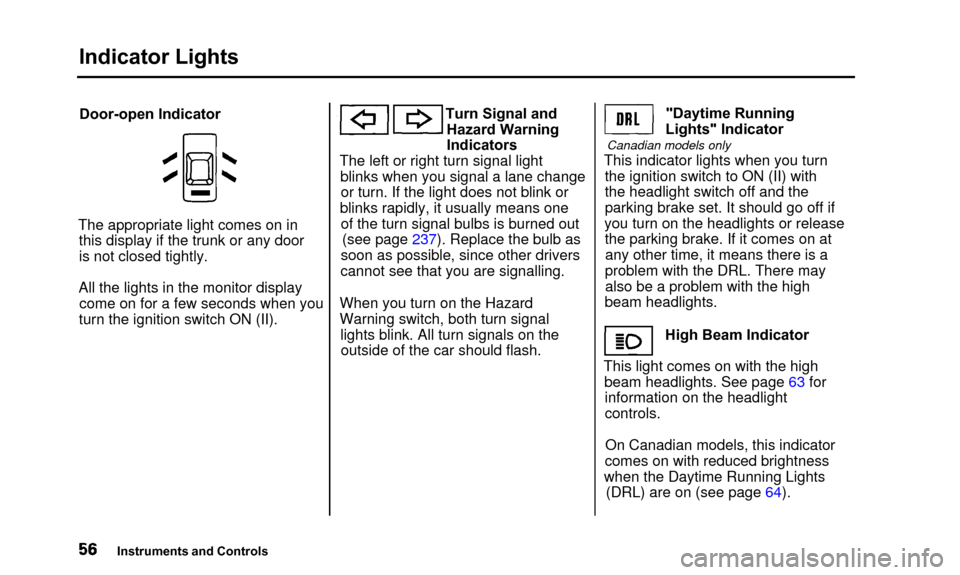
Indicator Lights
Door-open Indicator
The appropriate light comes on in this display if the trunk or any door
is not closed tightly.
All the lights in the monitor display come on for a few seconds when you
turn the ignition switch ON (II). Turn Signal and
Hazard Warning
Indicators
The left or right turn signal light blinks when you signal a lane changeor turn. If the light does not blink or
blinks rapidly, it usually means one of the turn signal bulbs is burned out (see page 237). Replace the bulb as
soon as possible, since other drivers
cannot see that you are signalling.
When you turn on the Hazard
Warning switch, both turn signal lights blink. All turn signals on theoutside of the car should flash. "Daytime Running
Lights" Indicator
Canadian models only
This indicator lights when you turn the ignition switch to ON (II) with
the headlight switch off and the
parking brake set. It should go off if
you turn on the headlights or release the parking brake. If it comes on atany other time, it means there is a
problem with the DRL. There may also be a problem with the high
beam headlights.
High Beam Indicator
This light comes on with the high beam headlights. See page 63 forinformation on the headlight
controls.
On Canadian models, this indicator
comes on with reduced brightness
when the Daytime Running Lights (DRL) are on (see page 64).
Instruments and Controls
Page 60 of 311
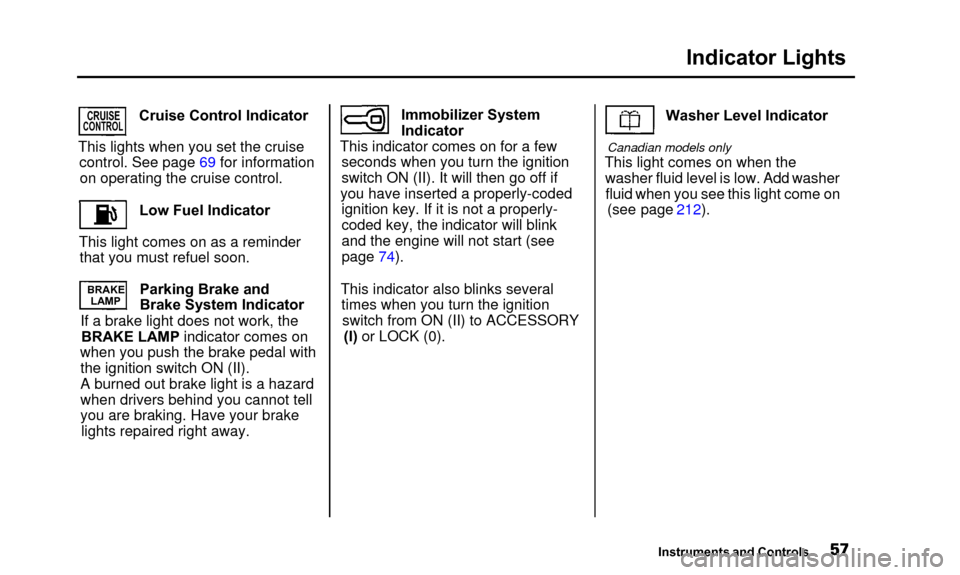
Indicator Lights
CRUISECONTROLCruise Control Indicator
This lights when you set the cruise control. See page 69 for informationon operating the cruise control.
Low Fuel Indicator
This light comes on as a reminder that you must refuel soon.
BRAKE LAMPParking Brake and
Brake System Indicator
If a brake light does not work, the BRAKE LAMP indicator comes on
when you push the brake pedal with the ignition switch ON (II).
A burned out brake light is a hazard
when drivers behind you cannot tell
you are braking. Have your brake lights repaired right away. Immobilizer System
Indicator
This indicator comes on for a few seconds when you turn the ignition
switch ON (II). It will then go off if
you have inserted a properly-coded ignition key. If it is not a properly-
coded key, the indicator will blink
and the engine will not start (see
page 74).
This indicator also blinks several times when you turn the ignition switch from ON (II) to ACCESSORY (I) or LOCK (0). Washer Level Indicator
Canadian models only
This light comes on when the
washer fluid level is low. Add washerfluid when you see this light come on (see page 212).
Instruments and Controls
Page 67 of 311
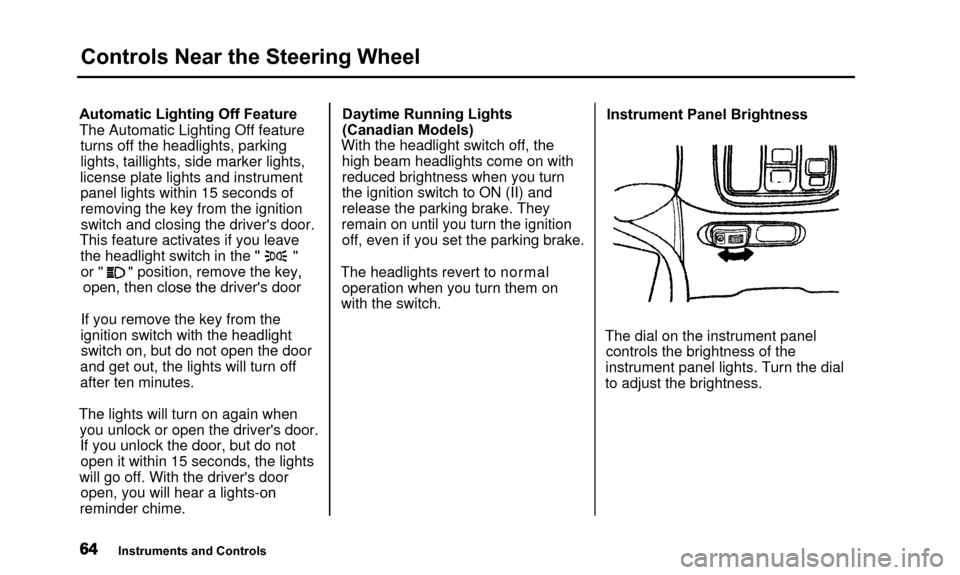
Controls Near the Steering Wheel
Automatic Lighting Off Feature
The Automatic Lighting Off featureturns off the headlights, parking
lights, taillights, side marker lights,
license plate lights and instrument panel lights within 15 seconds ofremoving the key from the ignition switch and closing the driver's door.
This feature activates if you leave the headlight switch in the " "or " " position, remove the key,,
open, then close the driver's door
If you remove the key from the
ignition switch with the headlight switch on, but do not open the door
and get out, the lights will turn off
after ten minutes.
The lights will turn on again when you unlock or open the driver's door.If you unlock the door, but do notopen it within 15 seconds, the lights
will go off. With the driver's door open, you will hear a lights-on
reminder chime. Daytime Running Lights
(Canadian Models)
With the headlight switch off, the high beam headlights come on with
reduced brightness when you turn
the ignition switch to ON (II) and
release the parking brake. They
remain on until you turn the ignition off, even if you set the parking brake.
The headlights revert to normal operation when you turn them on
with the switch. Instrument Panel Brightness
The dial on the instrument panel controls the brightness of the
instrument panel lights. Turn the dial
to adjust the brightness.
Instruments and Controls
Page 69 of 311
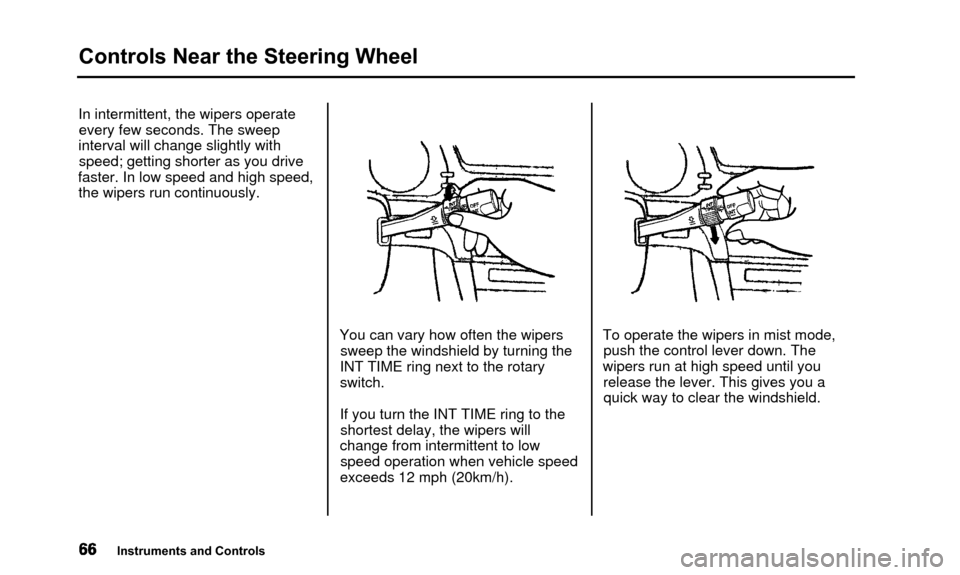
Controls Near the Steering Wheel
In intermittent, the wipers operateevery few seconds. The sweep
interval will change slightly with speed; getting shorter as you drive
faster. In low speed and high speed, the wipers run continuously.
You can vary how often the wiperssweep the windshield by turning the
INT TIME ring next to the rotary
switch.
If you turn the INT TIME ring to the shortest delay, the wipers will
change from intermittent to low speed operation when vehicle speed
exceeds 12 mph (20km/h). To operate the wipers in mist mode,
push the control lever down. The
wipers run at high speed until you release the lever. This gives you aquick way to clear the windshield.
Instruments and Controls